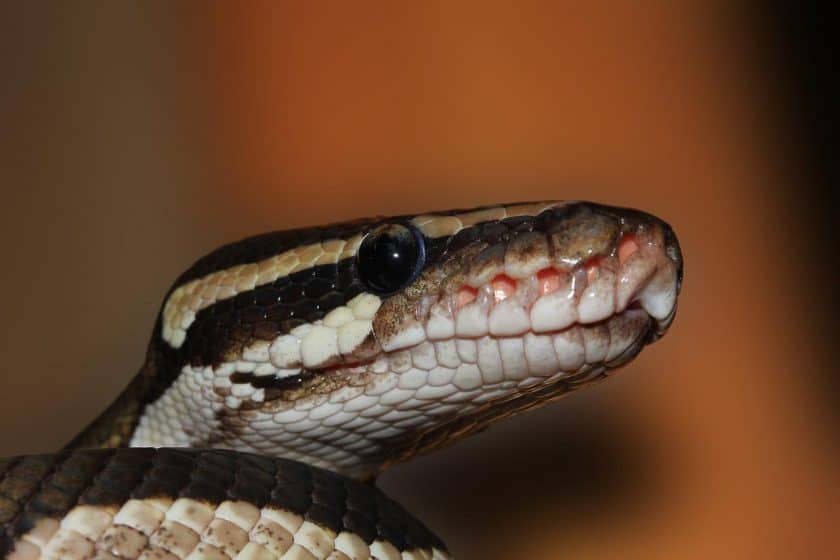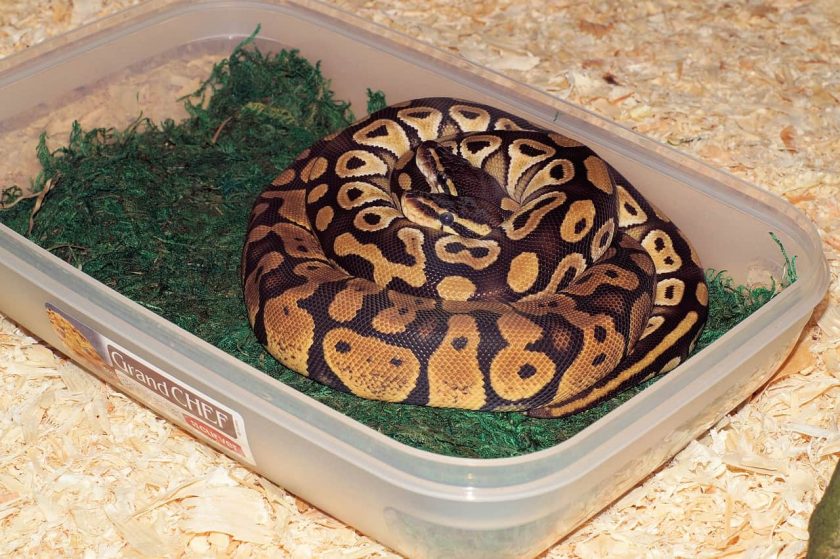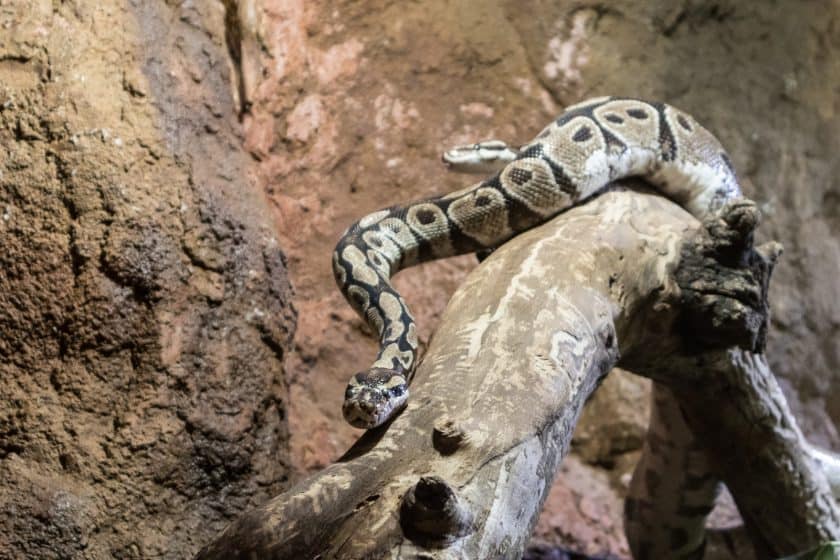Ball Python Mouth Rot: Prevention, Symptoms & Treatment
Ball pythons mouth rot, also called stomatitis, is a very serious condition that can quickly lead to death if left untreated. In this article, We’ll discuss what mouth rot is, how to spot the signs of infection and the best ways to treat it.

Looking after your ball python is most important for their overall health. This includes regular cleaning of their enclosure, providing fresh water, and a nutritious diet. Neglecting these basic husbandry requirements can lead to a weakened immune system and make your ball python more susceptible to mouth rot.
If you’re a reptile enthusiast, you may have heard of mouth rot – and if you haven’t, it’s definitely something you want to avoid. I have personally seen many cases of ball python mouth rot and it is always a heartbreaking experience. Seeing a once-healthy snake suffer from this painful condition is something no reptile owner ever wants to go through.
Mouth rot is a painful and potentially deadly infection of the mouth and throat tissues also called oral sepsis or ulcerative stomatitis. It’s most common in reptiles, and ball pythons are no exception. It is caused by a number of different bacteria and fungi.
Bacteria:
- Escherichia coli
- Pseudomonas aeruginosa
- Morganella morganii
- Klebsiella pneumonia
Fungus:
- Aspergillus sp.
If you want to learn more about ball python mouth rot, keep reading. This article will cover everything you need to know, including the symptoms, treatment, and prevention of this condition.
What Does Ball Python Mouth Rot Look Like?
If your ball python has mouth rot, you’ll notice that its mouth is red and inflamed. In severe cases, the tissue may be ulcerated, and pus or blood may be visible. Your ball python may also have difficulty eating, and you may see them drooling or foaming at the mouth.
What Symptoms of Mouth Rot in Ball Python?
In addition to the visible signs of infection, your ball python may also show other symptoms that something is wrong. These may include:
- Loss of Appetite
- Weight loss
- Respiratory distress
- Discharge or bleeding in or around the mouth
- Foul smell
- Swollen mouth
- Open-mouth breathing
- Excessive salivation
In later stages, the infection can spread to the upper alimentary tract causing Upper Alimentary Tract Disease (UATD). The severe signs include:
- Paralysis in the jaw
- Swollen head
- Gum swelling
- Necrosis of the mouth
- Fluid draining from the nose and mouth
- Pus or Blood from the mouth
- Teeth loss
- Face edema
- Bulging eyes
Related: Ball Python Care Sheet
What Are the Causes of Mouth Rot in Ball Pythons?

Mouth rot is most often caused by poor husbandry and hygiene. If your ball python’s enclosure is not clean, this can lead to a build-up of bacteria and fungi, which can then infect your snake. Other risk factors include a lack of vitamin C, malnutrition, mouth injury, and a weakened immune system.
Malnutrition
Malnutrition can also weaken your ball python’s immune system and make them more susceptible to mouth rot. This is why it’s so important to feed your ball python a nutritious diet that contains all the vitamins and minerals they need.
Mouth Injuries
Mouth injuries are another common cause of mouth rot. If your ball python has a cut or scrape in its mouth, this can provide an entry point for bacteria and fungi. It’s important to inspect your ball python’s mouth regularly and look for any signs of injury.
Wakened Immune System
A weakened immune system can also make your ball python more susceptible to infection. This can be caused by a number of things, including stress, illness, and old age.
How Is Mouth Rot Diagnosed?
If you suspect that your ball python has mouth rot, it’s important to take them to the vet immediately. The sooner the infection is diagnosed and treated, the better the chances are for a full recovery.
Physical Examination
There are a few different ways that your vet can diagnose mouth rot. A physical examination of your ball python’s mouth will be done first. Your vet will look for any signs of infection, such as redness, swelling, or ulceration.
Cytology/Cultures
Your vet may also collect a sample of your ball python’s mouth discharge for analysis. This can be done with a swab or by aspirating fluid from the infected area. The sample will then be examined under a microscope or cultured in a lab to determine what kind of bacteria or fungus is present.
Biopsy
In some cases, a biopsy may also be necessary. This is a procedure where a small piece of tissue is removed from the mouth and examined under a microscope. A biopsy can help to confirm the diagnosis and rule out other conditions.
How Do You Treat Ball Python Rot Mouth?
Mouth rot is a serious condition that requires prompt treatment. Depending on the severity of the infection, treatment may be done at home or in the hospital.
Mild Cases
Mild cases of mouth rot can often be treated with oral antibiotics. These are typically given for 14-21 days. Your vet may also recommend a mouthwash or topical cream to help soothe the area and speed up healing.
Severe Cases
More severe cases of mouth rot may require hospitalization. Your ball python will need to be treated with intravenous antibiotics and supportive care. In some cases, surgery may also be necessary to remove dead tissue.
Once the infection has cleared, your ball python will need to be monitored closely. They may need to stay on oral antibiotics for several weeks or months to prevent the infection from coming back. Your vet will also likely recommend multivitamin supplements to help restore their immune system.
What Is the Prognosis for Mouth Rot?

The prognosis for mouth rot depends on the severity of the infection. If the infection is caught early and treated promptly, the prognosis is good. However, if the infection is allowed to spread, it can be fatal.
How Do You Prevent a Ball Python Rot Mouth?
The best way to prevent mouth rot is to practice good husbandry and hygiene. There are a few things you can do to help prevent mouth rot in your ball python.
Humidity
Maintain proper humidity levels in your ball python’s enclosure. The ideal range is 50-65%.
Temperature
Maintaining the proper temperature and humidity levels in your ball python’s enclosure is important. This will help to prevent stress and keep their immune system strong.
| Area | Température ºF | Température ºC |
| Cool side | 75ºF to 80ºF | 24ºC – 26.5ºC |
| Warm side | 80ºF to 85ºF | 26.5ºC – 29ºC |
| Basking area | 88ºF to 92ºF | 31ºC – 33ºC |
Clean Enclosure
A clean enclosure is also important. Be sure to remove any waste or uneaten food from the enclosure daily. The enclosure should also be cleaned on regular basis. This will help to prevent the build-up of bacteria and fungi.
Nutritious Diet
Feeding your ball python a nutritious diet is also important. This will help to keep their immune system strong and reduce the risk of infection.
Let’s Wrap This Up
Mouth rot is a serious condition that can be fatal if not treated promptly. However, if the infection is caught early and treated properly, the prognosis is good. Be sure to practice good husbandry and hygiene to help prevent mouth rot in your ball python. If you think your ball python may have mouth rot, be sure to take them to the vet for treatment immediately.
I find mouth rot to be one of the most fatal – and serious – conditions that ball pythons can suffer from. It is important to provide accurate information about mouth rot so that snake keepers can be better equipped to deal with this condition if it arises. I hope that this article provides you with all the information you need to know about mouth rot in ball pythons.
We would love to hear about your experiences treating or preventing mouth rot in your ball pythons. If you have any questions that were not answered in this article, please feel free to reach out to us and we would be happy to help



2 Comments
My daughters ball python we think has lip rot she hit her face on the glass when trying to strike at rat and now her mouth is black what can we put on it
Hi Tammy,
It’s possible the black spot is a bruise or wound from the snake striking the glass. However, it could also be a sign of mouth rot, a serious infection requiring a veterinarian’s attention. I strongly recommend scheduling an appointment with a reptile vet immediately. They’ll be able to diagnose the problem and prescribe the appropriate treatment.
Until the vet visit, gently clean the affected area with a diluted antiseptic solution like chlorhexidine or Betadine.
It’s also important to double-check your snake’s enclosure to ensure it’s the right size, has proper temperature control, and includes enough hiding places to prevent future accidents and reduce stress.
Please don’t try to treat suspected mouth rot with home remedies, as these can make things worse. Minimize your handling of the snake until the vet appointment to further reduce stress.
Let me know if you have any other questions. I wish the best for your daughter’s ball python!